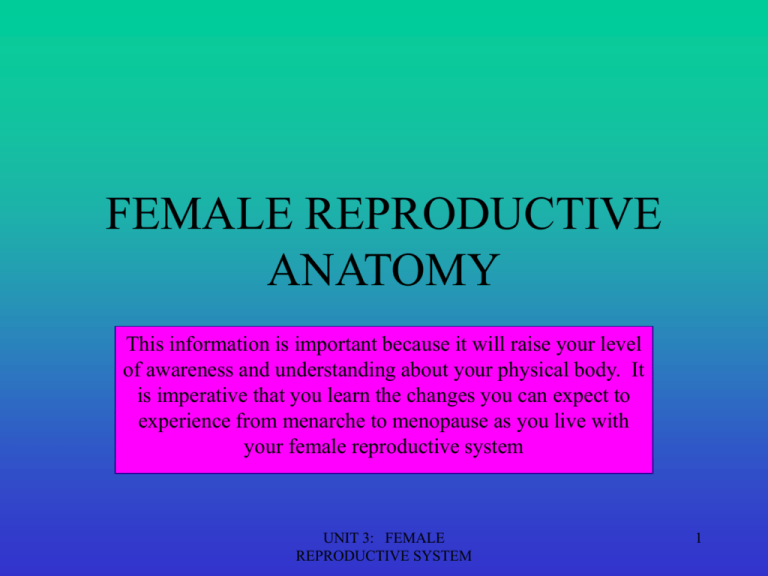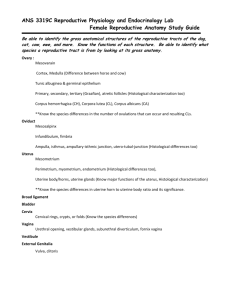
FEMALE REPRODUCTIVE
ANATOMY
This information is important because it will raise your level
of awareness and understanding about your physical body. It
is imperative that you learn the changes you can expect to
experience from menarche to menopause as you live with
your female reproductive system
UNIT 3: FEMALE
REPRODUCTIVE SYSTEM
1
EXTERNAL GENTILIA
• The vulva refers to those parts
that are outwardly visible
• The vulva includes:
• Mons pubis
• Labia majora
• Labia minora
• Clitoris
• Urethral opening
• Vaginal opening
• Perineum
• Individual differences
in:
• Size
• Coloration
• Shape
• Of external gentalia
are common
UNIT 3: FEMALE
REPRODUCTIVE SYSTEM
2
MONS PUBIS
• The triangular mound of fatty tissue that
covers the pubic bone
• It protects the pubic symphysis
• During adolescence sex hormones trigger
the growth of pubic hair on the mons pubis
• Hair varies in coarseness curliness, amount,
color and thickness
UNIT 3: FEMALE
REPRODUCTIVE SYSTEM
3
LABIA MAJORA
•
•
•
•
•
•
•
Referred to as the outer lips
They have a darker pigmentation
The Labia Majora:
Protect the introitus and urethral openings
Are covered with hair and sebaceous glands
Tend to be smooth, moist, and hairless
Become flaccid with age and after childbirth
UNIT 3: FEMALE
REPRODUCTIVE SYSTEM
4
LABIA MINORA
• Referred to as the “inner lips”
• Made up of erectile, connective tissue that
darkens and swells during sexual arousal
• Located inside the labia majora
• They are more sensitive and responsive to
touch than the labia majora
• The labia minora tightens during intercourse
UNIT 3: FEMALE
REPRODUCTIVE SYSTEM
5
CLITORIS
• Highly sensitive organ composed of nerves, blood
vessels, and erectile tissue
• Located under the prepuce
• It is made up of a shaft and a glans
• Becomes engorged with blood during sexual
stimulation
• Key to sexual pleasure for most women
• Urethral opening is located directly below
clitoris
UNIT 3: FEMALE
REPRODUCTIVE SYSTEM
6
VAGINAL OPENING
INTROITUS
• Opening may be covered by a thin sheath
called the hymen
• Using the presence of an intact hymen for
determining virginity is erroneous
• Some women are born without hymens
• The hymen can be perforated by many
different events
UNIT 3: FEMALE
REPRODUCTIVE SYSTEM
7
PERINEUM
• The muscle and tissue located between the vaginal
opening and anal canal
• It supports and surrounds the lower parts of the
urinary and digestive tracts
• The perinium contains an abundance of nerve
endings that make it sensitive to touch
• An episiotomy is an incision of the perineum used
during childbirth for widening the vaginal opening
UNIT 3: FEMALE
REPRODUCTIVE SYSTEM
8
INTERNAL GENITALIA
•
•
•
•
•
•
The internal genitalia consists of the:
Vagina
Cervix
Uterus
Fallopian Tubes
Ovaries
UNIT 3: FEMALE
REPRODUCTIVE SYSTEM
9
VAGINA
•
•
•
•
•
•
•
The vagina connects the cervix to the external genitals
It is located between the bladder and rectum
It functions :
As a passageway for the menstrual flow
For uterine secretions to pass down through the introitus
As the birth canal during labor
With the help of two Bartholin’s glands becomes lubricated
during SI
UNIT 3: FEMALE
REPRODUCTIVE SYSTEM
10
CERVIX
• The cervix connects the uterus to the vagina
• The cervical opening to the vagina is small
• This acts as a safety precaution against
foreign bodies entering the uterus
• During childbirth, the cervix dilates to
accommodate the passage of the fetus
• This dilation is a sign that labor has begun
UNIT 3: FEMALE
REPRODUCTIVE SYSTEM
11
UTERUS
• Commonly referred to as the womb
• A pear shaped organ about the size of a clenched fist
• It is made up of the endometrium, myometrium and
perimetrium
• Consists of blood-enriched tissue that sloughs off each
month during menstrual cycle
• The powerful muscles of the uterus expand to
accommodate a growing fetus and push it through the birth
canal
UNIT 3: FEMALE
REPRODUCTIVE SYSTEM
12
FALLOPIAN TUBES
•
•
•
•
Serve as a pathway for the ovum to the uterus
Are the site of fertilization by the male sperm
Often referred to as the oviducts or uterine tubes
Fertilized egg takes approximately 6 to 10 days to
travel through the fallopian tube to implant in the
uterine lining
UNIT 3: FEMALE
REPRODUCTIVE SYSTEM
13
OVARIES
• The female gonads or sex glands
• They develop and expel an ovum each month
• A woman is born with approximately 400,000 immature
eggs called follicles
• During a lifetime a woman release @ 400 to 500 fully
matured eggs for fertilization
• The follicles in the ovaries produce the female sex
hormones, progesterone and estrogen
• These hormones prepare the uterus for implantation of the
fertilized egg
UNIT 3: FEMALE
REPRODUCTIVE SYSTEM
14
BREASTS
•
Organs of sexual arousal
• Contain mammary glands
• Consist of connective tissue that
serves as support
• Each breast contain 15-25
clusters called lobes
• Each lobule is connected by
ducts that open into the nipples
• The nipples are made up of
erectile tissue
• The pigmented around the
nipples are called the areola
• Breast size is determined
primarily by heredity
• Size also depends on the
existing fat and glandular tissue
• Breasts may exhibit cyclical
changes, including increased
swelling and tenderness prior to
menstruation
• Benign breast changes refer to
fibrocystic disease
• Lumps or masses that are
noncancerous
UNIT 3: FEMALE
REPRODUCTIVE SYSTEM
15
BREAST SELFEXAMINATION
• Women need to examine their breasts
monthly BSE
• This is a proactive approach to detect
possible breast cancer
• A supplement to clinical exams and
mammography
• Best time for a BSE is a week after
menstruation
UNIT 3: FEMALE
REPRODUCTIVE SYSTEM
16
MENSTRUATION
• Menarch, the onset of
menstruation signals the bodily
changes that transform a female
body
• Average age is 12.8
• Amount of bleeding varies from
woman to woman
• Expulsion of blood clots
• Blood color can vary from
bright red to dark maroon
• Usually occurs every 25 to 32
days
• Women can experience fluid
retention, cramping, mood
swings, weight gain, breast
tenderness, diarrhea, and
constipation
UNIT 3: FEMALE
REPRODUCTIVE SYSTEM
17
SEX HORMONES
• Follicle stimulating hormone
FHS• Luteinizing hormone LHsignals ovulation
• Estrogen- produced throughout
the menstrual cycle
• Progesterone-produced during
second half of cycle
• Contributes to thickening of the
endometrium which is shed
during menstrual phase if
fertilization does not take place
• Both FHS and LH are
produced in the
pituitary gland
• Both estrogen and
progesterone are
produced by the
follicles in the ovaries
UNIT 3: FEMALE
REPRODUCTIVE SYSTEM
18
DYSMENORRHEA
• Painful menstrual cramps
• Painful menses without evidence of a physical abnormality
• Believed to be normal body response to uterine
contractions
• Other symptoms :
• Nausea, vomiting, gastrointestinal disturbances, and
fainting
• Prostaglandins cause forceful, frequent uterine contractions
called cramps
• Fibroids, polyps, IUD, PID, or endometriosis
UNIT 3: FEMALE
REPRODUCTIVE SYSTEM
19
ENDOMETRIOSIS
• Common cause of dysmennorrhea, dyspareunia,
and infertility
• Endometrium fragments and lodges in other parts
of the pelvic cavity
• Causes inflammation, bleeding, scarring,and
adhesions
• Causes are still being studied
• Treated through hormonal therapy, laparoscopic
surgery, or major surgical management
UNIT 3: FEMALE
REPRODUCTIVE SYSTEM
20







